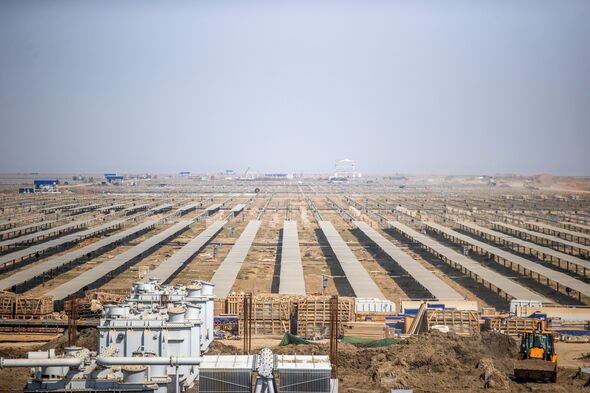Located very close to the India-Pakistan border lies an incredible under-construction megaproject that will break records in renewable energy.
The Gujarat Hybrid Renewable Energy Park, or Khavda Solar Park, covers such a huge area – around 72,600 hectares or 280 square miles – that it will be roughly the size of the entire country of Singapore.
It is so vast that it can actually be seen directly from space.
When completed, it will be the biggest hybrid renewable energy park in the world, with a capacity of as much as 30 gigawatts (GTW) from both solar panels and wind turbines.
This amount of electricity could power around 18 million Indian homes.
It is also hoped the park will avoid an estimated 58 million tonnes of carbon dioxide emissions annually, according to energy institute.
India – the world’s most populous country – aims to install 500 gigawatts of clean energy by the end of the decade and reach net zero emissions by 2070.
Over 70% of India’s electricity is still generated by fossil fuels, especially coal. The country is also the third-largest emitter of planet-warming gases behind China and the US.
The park’s proposal was approved by the Government of Gujarat in September 2020, and 60,000 hectares of salt desert were allocated near Vighakot village in the Kutch district of Gujarat. The proposal initially mentioned a total 41.5 GW capacity.
Indian Prime Minister, Narendra Modi, laid the project’s foundation stone on in December 2020 and the first 250 MW of wind power came online in July 2024.
The entire $20 billion (£16 billion) facility is expected to become commercially operational by late 2025 and be fully complete by December 2026.
Thousands of labourers are installing solar panels that stretch as far as the eye can see, while others lay miles of wires or build the foundations for the enormous wind turbines being installed.
This is not the only impressive megaproject that India is undertaking. First envisioned in 1941, the country is currently building a two-mile-long dam that is slated to come into action as early as 2027.
The Polavaram Project, built on the Godavari River in Andhra Pradesh, will solve India’s critical problems in water management, irrigation and energy supply. It will be the third longest in length, dwarfing the Hoover Dam and changing the lives of millions of people.
Meanwhile, a joint venture between India and Japan – the DMIC project – is set to cost a staggering £77 billion and will see the creation of eight new cities built from scratch between Delhi and Mumbai.
